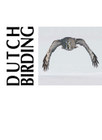Dutch Birding volume 31 (2009) no 6

Pale Barn Owls in the Netherlands: occurrence and identification
This paper describes the occurrence and identification of Pale Barn Owl Tyto alba alba (hereafter alba) in the Netherlands, where 'pale' Dark Barn Owls T a guttata (hereafter guttata) cause confusion as they are often difficult to separate from alba. In Britain, the situation is the opposite: alba is breeding and guttata a vagrant and 'dark' alba's may cause identification problems.
Based on skins and literature, the following differences are noted:
Upperside: 1 guttata is variable, from yellow-brown to (mostly) red-brown, but usually red-brown; 2 guttata has on average more grey than red-brown markings; this grey is generally darker than in alba; 3 alba is variable but always more or less yellow-brown; and 4 alba has on average as much as or less grey than yellow-brown markings; this grey is generally paler than in guttata.
Underside: 1 guttata is variable, always has dark spots on the underparts and never completely white underparts without spots; 2 guttata has variable dark markings on the underside of the outer primaries; in general, these markings are quite obvious and almost never completely absent; 3 guttata has variable dark markings on the underside of the tail but these are almost always visible; furthermore, the ground colour of the underside of the tail is largely buff and less often white; 4 alba has pale underparts (sometimes creamy, especially on the breast) without or only with just a few dark spots; 5 alba has variable dark markings on the underside of the outer primaries; in general, these markings are less heavy than in guttata and regularly completely absent; and 6 alba has variable dark markings on the underside of the tail and generally these markings are less heavy than in guttata and regularly completely absent; furthermore, the ground colour of the underside of the tail is largely white or grey and less often buff.
It can be concluded that, at least in the Netherlands, only the palest alba can be identified with certainty and exclude pale guttata. An alba should meet most (and preferably all) of the following criteria: 1 yellow-brown upperside; 2 not too many grey markings on upperside; 3 grey on upperside pale; 4 white underside without or with only slight amount of cream coloration; 5 (almost) no dark spots on underparts; 6 no or only minimal amount of dark markings on the underside of the outer primaries; and 7 white or grey underside of the tail without or with only slight amount of dark markings.
In the Netherlands, c 3000 breeding pairs of guttata were counted in 2008 and it is regarded as rather common. In table 1, all three records and six reports of alba still under consideration (or not yet submitted) are listed.In each alba record, a possible captive origin should be taken into account as there are several cases of birds raised in captivity that were released in the wild and were able to survive.
Chris van Rijswijk, Soderblomplaats 702, 3069 ST Rotterdam, Nederland
(cdvrijswijk gmail.com)
gmail.com)
terug






